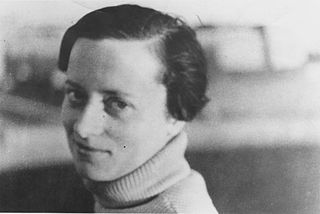
The French School of the Far East, abbreviated EFEO, is an associated college of PSL University dedicated to the study of Asian societies. It was founded on 20 January 1900 with headquarters in Hanoi in what was then Tonkin protectorate of French Indochina. After the independence of Vietnam, its headquarters were transferred to Phnom Penh in 1957, and subsequently to Paris in 1975. Its main fields of research are archaeology, philology and the study of modern Asian societies. Since 1907, the EFEO has been in charge of conservation work at the archeological site of Angkor.

Julien Michel Leiris was a French surrealist writer and ethnographer. Part of the Surrealist group in Paris, Leiris became a key member of the College of Sociology with Georges Bataille and head of research in ethnography at the CNRS.

Paul Sébillot was a French folklorist, painter, and writer. Many of his works are about his native province, Brittany.

The Musée de l'Homme is an anthropology museum in Paris, France. It was established in 1937 by Paul Rivet for the 1937 Exposition Internationale des Arts et Techniques dans la Vie Moderne. It is the descendant of the Musée d'Ethnographie du Trocadéro, founded in 1878. The Musée de l'Homme is a research center under the authority of various ministries, and it groups several entities from the CNRS. The Musée de l'Homme is one of the seven departments of the Muséum national d'histoire naturelle. The Musée de l'Homme occupies most of the Passy wing of the Palais de Chaillot in the 16th arrondissement. The vast majority of its collection was transferred to the Quai Branly museum.

Françoise Héritier was a French anthropologist, ethnologist, and feminist. She was the successor to Claude Lévi-Strauss to hold the chair of anthropology at the Collège de France, and held the inaugural chair of Comparative Study of African Societies from 1983. Her work dealt mainly with the theory of alliances and on the prohibition of incest, both theories based on the notion of exchange of women. In addition to Lévi-Strauss, she was also influenced by Alfred Radcliffe-Brown.

The Musée du Quai Branly – Jacques Chirac, located in Paris, France, is a museum designed by French architect Jean Nouvel to feature the indigenous art and cultures of Africa, Asia, Oceania, and the Americas. The museum collection comprises more than a million objects, of which 3,500 are on display at any given time, in both permanent and temporary thematic exhibits. A selection of objects from the museum is also displayed in the Pavillon des Sessions of the Louvre.

André Leroi-Gourhan was a French archaeologist, paleontologist, paleoanthropologist, and anthropologist with an interest in technology and aesthetics and a penchant for philosophical reflection.

Georges Balandier was a French sociologist, anthropologist and ethnologist noted for his research in Sub-Saharan Africa. Balandier was born in Aillevillers-et-Lyaumont. He was a professor at the Sorbonne, and is a member of the Center for African Studies, a research center of the École pratique des hautes études. He held for many years the Editorship of Cahiers Internationaux de Sociologie and edited the series Sociologie d'Aujourd'hui at Presses Universitaires de France. He was elected to the American Philosophical Society in 1976. He died on 5 October 2016 at the age of 95.
Marcel Samuel Raphaël Cohen was a French linguist. He was an important scholar of Semitic languages and especially of Ethiopian languages. He studied the French language and contributed much to general linguistics.

Boris Vildé was a linguist and ethnographer at the Musée de l'Homme, in Paris, France. He specialised in polar civilizations.
Carlo Severi is an Italian anthropologist who is Professor at the Ecole des Hautes Etudes en Sciences Sociales (EHESS). He is noted for his studies of ritual, image/imagination, and social memory

The Musée d'Ethnographie du Trocadéro was the first anthropological museum in Paris, founded in 1878. It closed in 1935 when the building that housed it, the Trocadéro Palace, was demolished; its descendant is the Musée de l'Homme, housed in the Palais de Chaillot on the same site, and its French collections formed the nucleus of the Musée National des Arts et Traditions Populaires, also in the Palais de Chaillot. Numerous modern artists visited it and were influenced by its "primitive" art, in particular Picasso during the period when he was working on Les Demoiselles d'Avignon (1907).
Stephen Cavanna Headley is a social anthropologist and a priest of the Eastern Orthodox Church. He is best known for his books on the anthropology of prayer and the ethnography of Central Java in Indonesia. He writes in French and English.
Deborah Lifchitz was a French-Jewish expert on Semitic languages of Ethiopia, who worked at the Musée de l'Homme in Paris and took part in the Mission Dakar Djibouti in 1932-3. The Nazis imprisoned her in 1942; she was murdered in Auschwitz.
Michel Cartry (1931–2008) was a French Africanist and anthropologist of religion.
Hugo Zemp is a Swiss-French ethnomusicologist. A prolific recorder of ethnic music and a writer on the subject, he has also shot a number of films about music of various regions, including 1988 film Voix de tête, voix de poitrine and 2002 film An African Brass Band filmed by him in Ivory Coast in 2002. His wide musical expertise includes music notably in Africa, Oceania and Switzerland. He also had particular interest in yodeling and lullabies.
Stéphane Breton is a French filmmaker, photographer and anthropologist.

Denise Paulme was a French Africanist and anthropologist. Her role in African literary studies, particularly in regards to the importance of Berber literature, was described as "pivotal".
Théodore Ber, was a French archaeologist and anthropologist who spent most of his adult life in Peru. Although an amateur, his work was appreciated by some scholars and officially recognized by the French government.

Jean Jamin was a French ethnologist and anthropologist. Director of studies at the School for Advanced Studies in the Social Sciences, he taught ethnology there from 1993 to 2016. He directed the journal L'Homme from 1996 to 2015 and co-founded the journal Gradhiva in 1986 alongside Michel Leiris. In the mid-1990s, he became a specialist in the study of the relationship between anthropology and literature, as well as between opera, jazz, popular music, and folk music.












